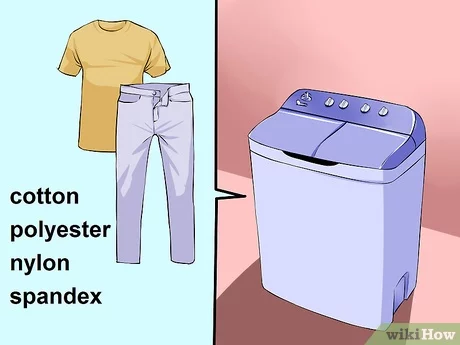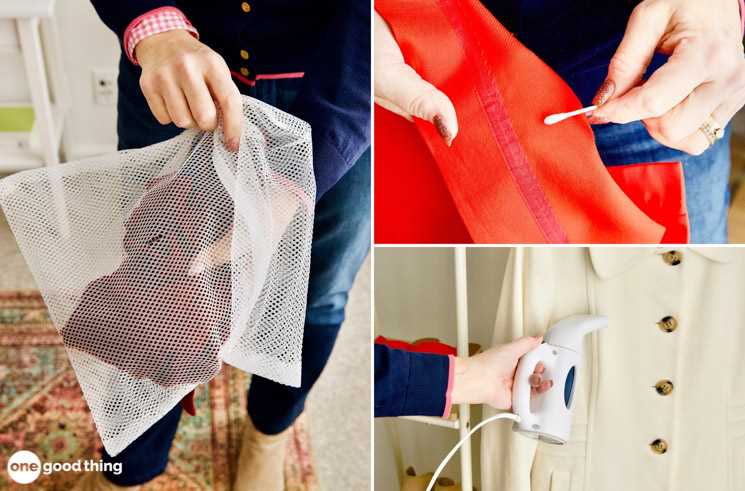
Dry cleaning is a professional laundering method that can remove stubborn stains and refresh garments without the use of water. While it used to be an expensive and time-consuming process, now you can do it in the comfort of your own home. In this step-by-step guide, we’ll walk you through the process of dry cleaning your clothes at home, saving you time and money.
Step 1: Check the Care Label
Before diving into the dry cleaning process, it’s important to check the care label on your clothing. Some fabrics and garments are not suitable for at-home dry cleaning and require special care. Make sure your clothing is labeled as “dry clean only” or “dry clean recommended” before proceeding.
Step 2: Spot Treat Stains
If you have any stains on your clothes, it’s crucial to treat them before dry cleaning. Using a stain remover or a gentle detergent, apply a small amount directly to the stain and gently rub it in. Let the product sit for a few minutes, then blot the stain with a clean cloth. Repeat this process until the stain is no longer visible.
Step 3: Use a Dry Cleaning Kit
Now it’s time to use a dry cleaning kit, which typically includes a stain remover, dry cleaning sheets, and a bag. Place your clothes and the dry cleaning sheet into the bag, following the instructions on the kit. Close the bag and shake it gently to distribute the cleaning solution. Let the bag sit for the recommended time on the kit instructions.
Step 4: Air Out the Clothes
After the recommended time has passed, take your clothes out of the bag and lay them flat on a clean surface. Let them air out for a few hours to allow any residual odors to dissipate. This step will ensure your clothes come out smelling fresh and clean.
Step 5: Steam or Iron if Necessary
Finally, if your clothes are wrinkled or have any creases, you can use a steamer or an iron to smooth them out. Be sure to follow the care instructions on the garment and use the appropriate heat settings for the fabric. Once your clothes are wrinkle-free, they’re ready to be worn or stored until the next use.
By following this step-by-step guide, you can successfully dry clean your clothes at home, saving time and money. Remember to always check the care label and spot treat any stains before proceeding. With a dry cleaning kit and a little patience, your clothes will come out fresh and ready to wear.
What is Dry Cleaning?

Dry cleaning is a professional method of cleaning clothes and fabrics without using water. It involves using solvents to remove stains and dirt from garments, making them look clean and fresh. The process of dry cleaning is typically performed by trained professionals at specialized dry cleaning facilities, but it is also possible to carry out certain dry cleaning techniques at home.
Dry cleaning is often the preferred method for cleaning delicate fabrics, such as silk, wool, and cashmere, which can be damaged by traditional washing methods. It is also used for garments that may shrink or lose their shape when exposed to water, as well as items with intricate embellishments or beading that could become damaged in a washing machine.
How Does Dry Cleaning Work?

The dry cleaning process typically involves the following steps:
- Pre-treatment: Any visible stains or spots on the garment are treated with a specialized solvent or stain remover to help break up the dirt and prepare the fabric for cleaning.
- Cleaning: The garment is immersed in a machine that uses a solvent, such as perchloroethylene (PERC), to dissolve and remove oil, grease, dirt, and other stains from the fabric.
- Rinsing: After cleaning, the garment may go through a rinsing process to remove any remaining solvent or cleaning agents.
- Drying: The garment is then dried using gentle heat or air to remove any remaining moisture.
- Finishing: Once dry, the garment is steamed or pressed to smooth out any wrinkles and restore its shape.
- Inspection: Finally, the garment is carefully inspected for any remaining stains or imperfections before being packaged and returned to the customer.
It’s important to note that dry cleaning should always be done following the care instructions on the clothing label. Some garments may not be suitable for dry cleaning and may require alternative methods of cleaning.
Can You Do Dry Cleaning at Home?
While professional dry cleaning is generally recommended for best results, there are certain items that can be safely dry cleaned at home using home dry cleaning kits. These kits typically contain a cleaning solvent and special cleaning cloths or pads that help to remove stains.
However, it’s important to exercise caution when attempting to dry clean at home, as certain fabrics or garments may still be better off being professionally cleaned. It’s always a good idea to test a small, inconspicuous area of the fabric first before proceeding with the entire item.
Additionally, if you’re dealing with a particularly stubborn stain or delicate fabric, it’s best to seek professional dry cleaning services to ensure the best results and avoid any potential damage.
Why Dry Clean Clothes at Home?

- Convenience: One of the main reasons to dry clean clothes at home is for the convenience it offers. Instead of taking your clothes to a dry cleaner and waiting for them to be ready, you can simply clean them in the comfort of your own home.
- Cost Savings: Dry cleaning can be expensive, especially if you have a lot of clothes that need to be cleaned regularly. By learning how to dry clean clothes at home, you can save money by avoiding the high costs associated with professional dry cleaning services.
- Control: When you dry clean clothes at home, you have complete control over the process. You can choose the cleaning products and methods that work best for your clothes, ensuring that they are treated gently and effectively.
- Time Savings: Going to a dry cleaner and waiting for your clothes to be cleaned can be time-consuming. By dry cleaning clothes at home, you can save time by eliminating the need to travel to and from a dry cleaner and wait for your clothes to be ready.
- Conscious Choice: Some people choose to dry clean clothes at home for environmental reasons. Professional dry cleaning often involves the use of chemicals that can be harsh on both clothes and the environment. By opting for home dry cleaning methods that use gentler products, you can make a more eco-friendly choice.
Step 1: Check the Labels

Before you start the dry cleaning process at home, it’s important to check the labels on your clothes to see if they are suitable for home dry cleaning. Look for the ‘Dry Clean Only’ label on the garment, as this indicates that the item is not safe to be washed using water and should only be cleaned using dry cleaning methods.
If the label does not have specific instructions, you can still try dry cleaning at home, but there is a risk of damaging the fabric or color. In such cases, it’s always better to take the garment to a professional cleaner.
- Read the Care Instructions: Pay attention to any specific care instructions mentioned on the label, such as recommended dry cleaning methods or any additional precautions to take.
- Fabric Type: Note the type of fabric used in the garment. Certain fabrics, such as silk or wool, are more delicate and require special care.
- Colorfastness: Check for any colorfastness warnings. Some fabrics may bleed or fade when exposed to the dry cleaning chemicals.
- Embellishments: Look for any attached embellishments or delicate details on the garment. These may require extra care or even handwashing instead of dry cleaning.
By checking the labels before proceeding, you can ensure that you are using the correct dry cleaning method for your clothes at home.
Understanding Fabric Types
Fabrics come in a wide variety of types, each with its own unique characteristics and care requirements. Understanding the fabric type is essential when it comes to dry cleaning clothes at home. Here are some common fabric types:
- Cotton: This natural fiber is known for its breathability and durability. It can usually be safely dry cleaned at home.
- Wool: Wool is a warm and insulating fiber that requires special care. It is best to leave wool items to professional dry cleaners.
- Silk: Silk is a delicate and lustrous fabric that requires gentle handling. Dry cleaning is often recommended for silk garments.
- Polyester: Polyester is a synthetic fabric that is known for its wrinkle resistance and durability. It can often be safely dry cleaned at home.
- Linen: Linen is a lightweight and breathable fabric that wrinkles easily. Dry cleaning or professional laundering may be required for linen items.
- Rayon: Rayon is a semi-synthetic fabric that is known for its softness and drape. It is important to check the care label for specific instructions on dry cleaning.
It is important to note that certain fabrics may have specific care instructions or require professional dry cleaning. Always check the care label on your garments for the recommended cleaning methods.
Furthermore, it is recommended to test a small, inconspicuous area of the fabric before attempting any dry cleaning methods at home to ensure that the fabric doesn’t get damaged or discolored.
By understanding the fabric types and their care requirements, you can ensure that you are using the appropriate dry cleaning methods at home and prolonging the lifespan of your clothes.
Determining Whether or Not to Dry Clean

Dry cleaning is a process that uses solvents to remove stains and dirt from clothing, without the use of water. It is commonly used for delicate or hard-to-clean fabrics, as well as items that require special care. However, not all clothing items need to be dry cleaned, and it is important to determine whether or not a particular item can be safely cleaned at home.
Check the Care Label
The first step in determining whether or not to dry clean a clothing item is to check the care label. The care label will provide information on how to clean the item, including whether or not it can be machine washed or dry cleaned. If the care label states that the item should be dry cleaned, it is best to follow the instructions to avoid damaging the garment.
Consider the Fabric
The type of fabric is an important factor to consider when deciding whether or not to dry clean. Some fabrics, such as silk, wool, or cashmere, may be too delicate or prone to shrinking or warping when exposed to water. These types of fabrics are best cleaned by a professional dry cleaner who has experience handling and caring for them.
On the other hand, there are fabrics that can be safely hand washed or machine washed at home, without the need for dry cleaning. Cotton, polyester, and denim are examples of fabrics that are typically safe to wash at home, as long as the care label permits it.
Assess the Stains and Odors
Another factor to consider is the nature of the stains and odors on the clothing item. Some stains, such as oil-based stains or stubborn dirt, may not be effectively removed through regular washing methods. Dry cleaning solvents are designed to break down and remove these types of stains, making dry cleaning a more effective option.
Similarly, if the clothing item has a strong or persistent odor, such as smoke or pet odors, dry cleaning can help eliminate the smell. The solvents used in the dry cleaning process are effective at removing odors, leaving the clothing item fresh and clean.
Consult a Professional
If you are unsure whether or not a clothing item can be safely dry cleaned at home, it is always best to consult a professional dry cleaner. They can provide expert advice based on the specific fabric and care instructions of the garment. They may also be able to recommend alternative cleaning methods or treatments for stubborn stains.
Remember, proper care and maintenance of your clothing items can help prolong their lifespan and keep them looking their best. If in doubt, it is always safer to err on the side of caution and seek professional help when it comes to dry cleaning.
Step 2: Pre-Treat Stains

Before you begin the dry cleaning process, it’s important to pre-treat any stains on your clothes. This will help ensure that the stains are removed effectively during the cleaning process.
1. Identify the Stains

Take a close look at your clothes and identify any stains that need to be treated. Common types of stains include oil, grease, grass, ink, and food stains.
2. Check the Care Label
Refer to the care label on your garments to see if there are any specific instructions for treating stains. Some fabrics may require special care, so it’s important to follow the manufacturer’s recommendations.
3. Determine the Best Treatment Method
Depending on the type of stain and fabric, different treatment methods may be required. Here are some common pre-treatment methods:
- Spot Cleaning: Gently blot the stain with a clean cloth or paper towel to remove any excess liquid or debris.
- Stain Remover: Apply a small amount of stain remover directly to the stain and gently rub it in using a clean cloth or sponge.
- Soaking: If the stain persists, you can try soaking the garment in a solution of water and mild detergent. Follow the instructions on the detergent packaging for the correct ratio.
4. Test Before Treating
Before applying any treatment method, it’s important to test it on a small, inconspicuous area of the garment to ensure that it doesn’t cause any damage or discoloration. Wait for the treated area to dry completely before proceeding.
5. Treat the Stains

Once you’ve determined the appropriate treatment method and tested it, you can proceed to treat the stains on your clothes. Follow the instructions provided for each specific method and allow the treatment to sit for the recommended amount of time.
6. Rinse or Blot
After treating the stains, rinse the garment thoroughly with clean water or gently blot the treated area with a clean cloth or sponge to remove any residue left behind by the treatment.
By pre-treating stains before dry cleaning, you increase the chances of successfully removing them and restoring the quality of your clothes.
Identifying Common Stains
Before beginning the dry cleaning process at home, it is important to identify the type of stain on your clothes. Different stains require different treatment methods, so proper identification is crucial for effective stain removal.
Here are some common types of stains and how to identify them:
- Oil-based stains: These stains are usually caused by substances like cooking oil, butter, or grease. They leave a greasy mark on the fabric and can be difficult to remove.
- Ink stains: Ink stains are typically caused by markers, pens, or printing ink. They are often dark in color and can spread quickly if not treated promptly.
- Food stains: Food stains can come from a variety of sources, such as coffee, wine, sauces, or fruits. They can leave visible discoloration or residue on the fabric.
- Blood stains: Blood stains can be caused by accidents or nosebleeds. They are usually red or brown in color and may be difficult to remove if they have already set.
- Grass stains: Grass stains are common on outdoor clothing and are typically green or yellow in color. They can be challenging to remove due to the chlorophyll content in grass.
These are just a few examples of common stains. Remember to always check the care label on your clothes and follow any specific instructions for stain removal. If you are unsure about how to treat a particular stain, it is best to consult a professional dry cleaner for advice.
FAQ
Can I dry clean my clothes at home?
Yes, you can dry clean your clothes at home using proper techniques and products.
Can I dry clean all types of fabrics at home?
No, not all types of fabrics can be dry cleaned at home. Some delicate or sensitive fabrics require professional dry cleaning to avoid damage.
Is it cheaper to dry clean clothes at home?
Yes, dry cleaning clothes at home can be cheaper than taking them to a professional dry cleaner. You only need to invest in the necessary products once, and you can reuse them multiple times.
What is dry cleaning?
Dry cleaning is a method of cleaning clothes that uses a chemical solvent instead of water.












